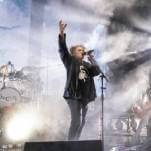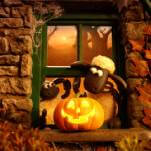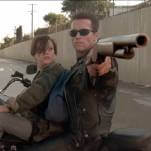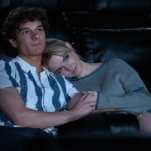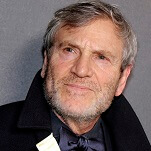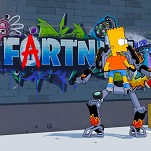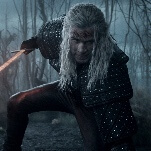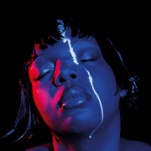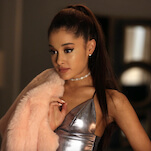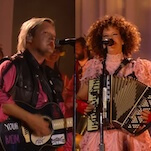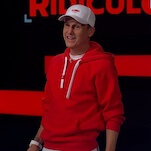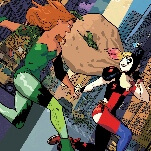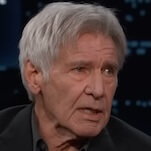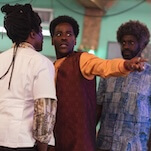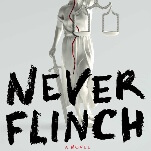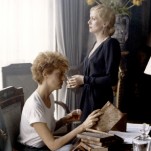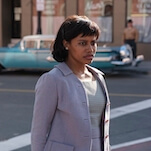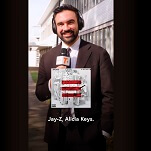Warning: This piece contains detailed discussion of the endings of both Me And Earl And The Dying Girl and The End Of The Tour.
Though it lasts less than three minutes and never really goes anywhere, Brian Eno’s “The Big Ship” is pregnant with profundity. An ouroboros of a song, it starts where it stops, and only ends in the sense that it eventually fades to silence. Yet you get the feeling that somewhere, somehow, it goes on forever, the loveliest drone album to never exist. Comprising just four chords—C, F, Am, and Gb (the G is accompanied by a B in the bassline)—it was a fragment of an unfinished song that Eno eventually crafted into the anti-centerpiece of his landmark 1975 album Another Green World. On the album, which vacillates between atmospheric moods and more classically structured songs, “The Big Ship” almost slips by unnoticed. It follows the brooding “In Dark Trees” (the precursor to David Bowie and Brian Eno’s Berlin Trilogy), and subsequently gets usurped by “I’ll Come Running,” a jarring bit of pop as infectious as poison ivy. On its own, purged of context, the song has the warm embrace of a hug and the stimulating result of a hot shower, offering comfort and proliferating epiphanies.
Forty years after its advent, the beguiling instrumental has unexpectedly resurfaced as the climactic song of two different films that debuted at Sundance less than 48 hours apart. In Alfonso Gomez-Rejon’s Me And Earl And The Dying Girl, “The Big Ship” permeates a meta-montage of homemade movies that plays as the titular girl fulfills her character description and dies. In the analog scene of The End Of The Tour, as journalist David Lipsky elegizes the iconic writer David Foster Wallace, the song serves a similar purpose, acting as a friend offering a hug in a time of need. Both movies feature self-loathing artists, yet the song pertains to each in subtly different ways.
Me And Earl And The Dying Girl concerns Greg (Thomas Mann), a high school boy and amateur filmmaker with a penchant for the Criterion Collection, who begrudging befriends Rachel (Olivia Cooke, who really needs better roles), a high school girl dying of cancer. To cheer her up, he reluctantly makes a film—“a shitty movie,” he calls it—that plays like a patchwork of moments from their friendship manifest as adolescent reimaginings of standout moments from classic films. The scene takes place in Rachel’s hospital room, dosed in a fervid red, where Greg projects his film on the wall. Me And Earl has been greeted with such fierce hostility by some critics, it makes you wonder if the director personally showed up to each of their houses and murdered their dogs. While the film has certain manipulative tendencies and its narrator’s self-loathing grows grating quickly, this climatic moment presents an undeniable poignancy. Brian Eno’s malleable song aids the scene, the slow swell of the destination-deprived track filling the empty space between moving images. Since Me And Earl references a ton of films and has a super-trendy indie soundtrack, the use of “The Big Ship” isn’t really out of place.
Eno’s immediately recognizable song doesn’t feel out of place in the less pop-culture-driven The End Of The Tour either, partially because Danny Elfman’s score channels Eno’s pensive aesthetic. In 2010, two years after Wallace’s suicide, David Lipsky reads from his book Although Of Course You End Up Becoming Yourself, on which the film is based. Lipsky spent four days accompanying Wallace on the tail end of his Infinite Jest book tour, during which the two discussed the foibles of writing while trading quips and increasingly caustic barbs. As Lipsky reads, recalling how Wallace believed that books existed as a way of combating loneliness, glimpses of the elusive writer dancing joyously drift across the screen in slow motion. Unlike the rest of the film, this isn’t presented as a memory: During their final conversation in 1996, Wallace revealed to Lipsky that he liked to go dancing at a local Episcopalian church, a tidbit of trivia that surprised Lipsky. (The cerebral Wallace doesn’t seem like the kind of guy who dances, let alone the kind of guy who dances at an Episcopalian church.) Since the entire film is rooted in Lipsky’s point of view, the slow-motion shot of Wallace throwing his flannel-clad arms up, grinning wide while jumping and gliding as if untethered by gravity, must be conjured in Lipsky’s imagination. The writer in mourning chooses to picture Wallace happy, if only for a brief moment.
The subtle but significant difference between the two scenes is the way they use Eno’s song: In The End Of The Tour, “The Big Ship” acts as consort to a celebratory moment taking place before the writer’s death, whereas Me And Earl employs the song at the moment of death (a death, by the way, that our narrator erroneously insisted would never happen, that liar), a sort of vessel escorting Rachel out of this world. “The Big Ship” works in both films, but its presence in The End Of The Tour is like a natural occurrence. It almost slips by, the same way it does on the album. Director James Ponsoldt elects to eschew any obvious explanation, but the song wasn’t simply chosen because it sounds nice. In his final novel, the posthumously released The Pale King (a streamlined amalgamation of myriad notes and pages Wallace left behind on paper and floppy discs, and scrawled across so many marble notebooks), Wallace cites Eno’s song for its ontological beauty:
This song is making me feel both warm and safe, as though cocooned like a little boy that’s just been taken out of the bath and wrapped in towels that have been washed so many times they’re incredibly soft, and also at the same time feeling sad; there’s an emptiness at the center of the warmth like the way an empty church or classroom with a lots of windows through which you can only see rain in the street is sad, as though right at the center of this safe, enclosed feeling is the seed of emptiness.
Of course, the song still enhances the scene’s beauty even if you haven’t read The Pale King. The genius of including it is its lack of genius: Eno once said, “Genius is individual, scenius is communal,” and this scene is, in the musician’s own invented parlance, completely scenius. The gift of sound and vision coalescing and creating a new aesthetic experience is something unique to movies, something Wallace’s writing, great as it is, could inherently never provide. “The Big Ship” extrapolates the unexpected bliss of Wallace letting loose, the man who uses a bandana to keep his head from exploding now losing himself gleefully to a song that goes nowhere.
Eno and Wallace share a similar affinity for pop that undergoes transmogrification, resulting in art: Eno flensed the hooks and choruses from his pop music so only the music’s essence was left lingering; Wallace took pop culture and exhumed its soul, using his slang-laced prose to dig at deeper, often darker truths. Eno’s carefully calculated percussion, cushioned by synths and shimmering keys like so many fireworks, has the temporal quality of a memory you’ll eventually forget. Its nebulous structure and lack of climax or closure makes it feel almost inconsequential, akin to one of Wallace’s irreverent endnotes. The song, like Wallace, contradicts itself. At once exact yet vague, it lends itself to two tonally different scenes in two aesthetically different films: one that elegizes death, and one that celebrates life. Like the scenes it accompanies, “The Big Ship” is a sustained sensation of a forever-fleeting moment, something as difficult to grasp as a fading memory.
